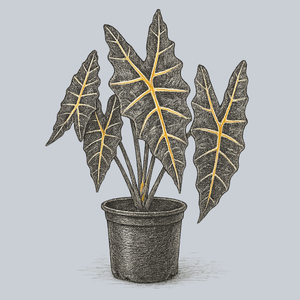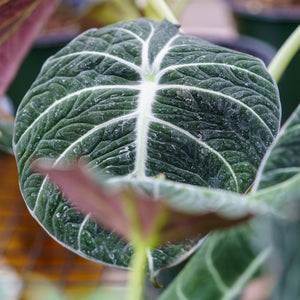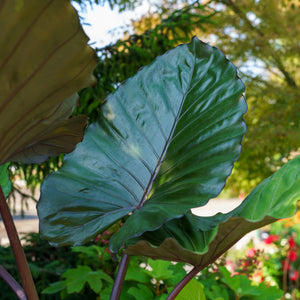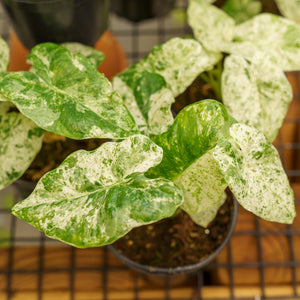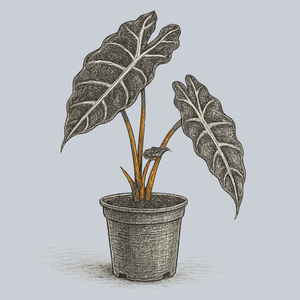The Alocasia Guide
Alocasia, commonly known as Elephant Ear, is a genus of tropical plants prized for their dramatic, arrow-shaped foliage and bold presence in indoor and outdoor gardens. Native to the tropical forests of Asia and Australia, these striking plants are cultivated for their unique leaf patterns, glossy textures, and sculptural appeal. With a wide variety of cultivars displaying shades of deep green, silver, purple, and even metallic hues, Alocasia is an exceptional choice for adding exotic beauty to any space. Here’s everything you need to know about growing and caring for Alocasia.
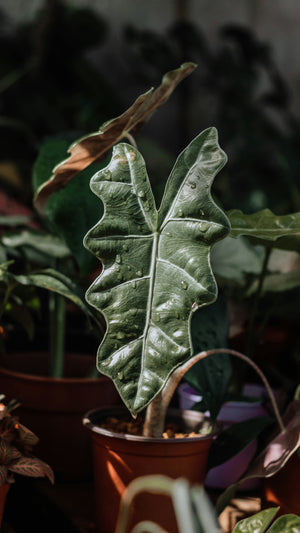
About
Alocasia belongs to the Araceae family and includes over 80 species, many of which have been hybridized into stunning ornamental cultivars. The plant's large, shield-like leaves emerge from thick, underground rhizomes, creating an impressive architectural element in both tropical landscapes and indoor collections.
Alocasia thrives in warm, humid conditions and requires bright, indirect light to maintain its vibrant foliage. Some of the most popular varieties include Alocasia baginda 'Dragon Scale', known for its textured, reptilian-like leaves; Alocasia 'Lauterbachiana', featuring deep green, velvety foliage with striking white veins; and Alocasia micholitziana 'Frydek', which boasts long, narrow, velvet-textured leaves with bright contrast veining.
Though visually stunning, Alocasia requires attentive care to thrive. With proper humidity, watering, and temperature control, these plants reward growers with fast growth and lush foliage. Whether displayed as a statement houseplant or grown in outdoor tropical gardens, Alocasia brings an unmatched level of sophistication to any setting.
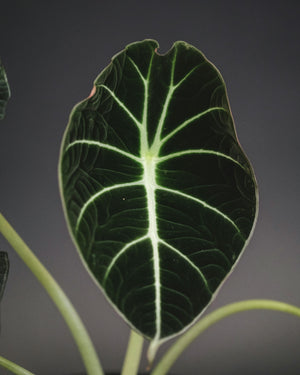
PLANTING
- USDA Hardiness Zones: Most Alocasia varieties thrive in Zones 9-11 when grown outdoors, though they are commonly cultivated as houseplants in cooler climates.
- Soil: Prefers a well-draining, loose potting mix with high organic content. A blend of peat, perlite, and orchid bark works well to maintain aeration.
- Sunlight: Requires bright, indirect light. Direct sunlight can scorch the leaves, while too little light may cause leggy growth.
- Watering: Water thoroughly when the top 2 inches of soil feel dry. Overwatering can lead to root rot, so ensure proper drainage.
- Spacing: Provide ample room for growth, as Alocasia can spread over time. If growing in a container, choose a pot with sufficient space for root expansion.
- Planting Time: Ideal planting time is in the spring or early summer when temperatures and humidity levels are consistently warm.
When planting or repotting, ensure the rhizome is positioned at soil level, with roots fully covered. Gently firm the soil around the base and water lightly to help settle the plant.
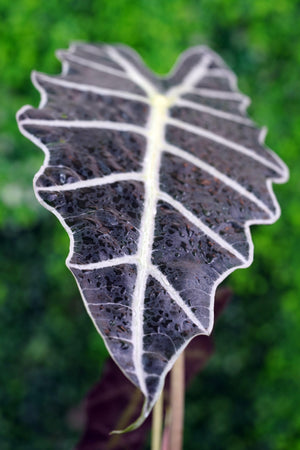
CARE
- Watering: Maintain consistent moisture without allowing the soil to become soggy. Reduce watering in winter when growth slows.
- Humidity: Prefers high humidity (above 60%). Use a pebble tray, humidifier, or regular misting to maintain ideal moisture levels.
- Fertilizing: Feed with a diluted balanced liquid fertilizer every 4-6 weeks during the growing season (spring and summer). Reduce feeding in fall and winter.
- Pruning: Remove yellowing or damaged leaves to encourage new growth and improve overall plant health.
- Pests & Diseases: Susceptible to spider mites, aphids, and mealybugs. Wipe leaves with neem oil or insecticidal soap as needed.
- Repotting: Repot every 1-2 years or when roots become root-bound. Use a well-draining potting mix and ensure adequate drainage.

HOW TO USE
Alocasia’s bold foliage and sculptural form make it a standout feature in various settings:
- Houseplants: Perfect as an indoor statement plant, thriving in bright, indirect light with proper humidity.
- Outdoor Landscaping: In tropical climates, Alocasia makes an excellent addition to shade gardens and water features.
- Container Gardening: Grows well in large pots on patios, balconies, or conservatories, where humidity can be controlled.
- Tropical Themed Gardens: Pairs beautifully with other tropical plants like ferns, calatheas, and philodendrons.
- Focal Point Planting: Large varieties create dramatic accents in indoor and outdoor spaces.
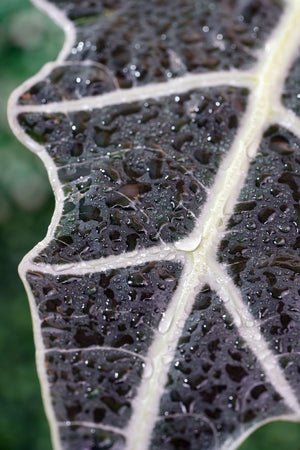
Common Questions
- Are Alocasia toxic to cats? Yes, Alocasia is toxic to cats due to insoluble calcium oxalate crystals, which can cause oral irritation, drooling, and digestive distress if ingested.
- Are Alocasia toxic to dogs? Yes, Alocasia is toxic to dogs and can cause similar symptoms, including mouth irritation and difficulty swallowing.
- How to propagate Alocasia? Alocasia can be propagated by dividing the rhizomes during repotting. Carefully separate offsets from the parent plant and replant in well-draining soil.
- How to care for Alocasia? Provide bright, indirect light, maintain high humidity, water when the top soil dries out, and fertilize during the growing season for optimal health.
- How often to water Alocasia? Water when the top 2 inches of soil feel dry. Avoid overwatering, as Alocasia is prone to root rot.
- Why is my Alocasia drooping? Drooping can be caused by underwatering, overwatering, temperature fluctuations, or low humidity. Assess soil moisture and environmental conditions to address the issue.
- Why is my Alocasia turning yellow? Yellowing leaves may indicate overwatering, insufficient light, or nutrient deficiencies. Adjust care routines accordingly to promote healthy foliage.
Conclusion
Alocasia is an exotic, eye-catching plant that brings a dramatic, tropical feel to both indoor and outdoor spaces. With its wide variety of leaf shapes, colors, and textures, this plant is perfect for adding a bold, modern aesthetic to any collection. Whether you prefer the deep hues of Alocasia reginula 'Black Velvet', the metallic sheen of Alocasia cuprea 'Red Secret', or the intricate patterns of Alocasia baginda 'Silver Dragon', there’s an Alocasia variety to suit every plant enthusiast. Explore our selection and experience the beauty of Alocasia in your home or garden.
The Alocasia Collection
Sold Out
Sold Out
Sold Out
Sold Out
Sold Out

